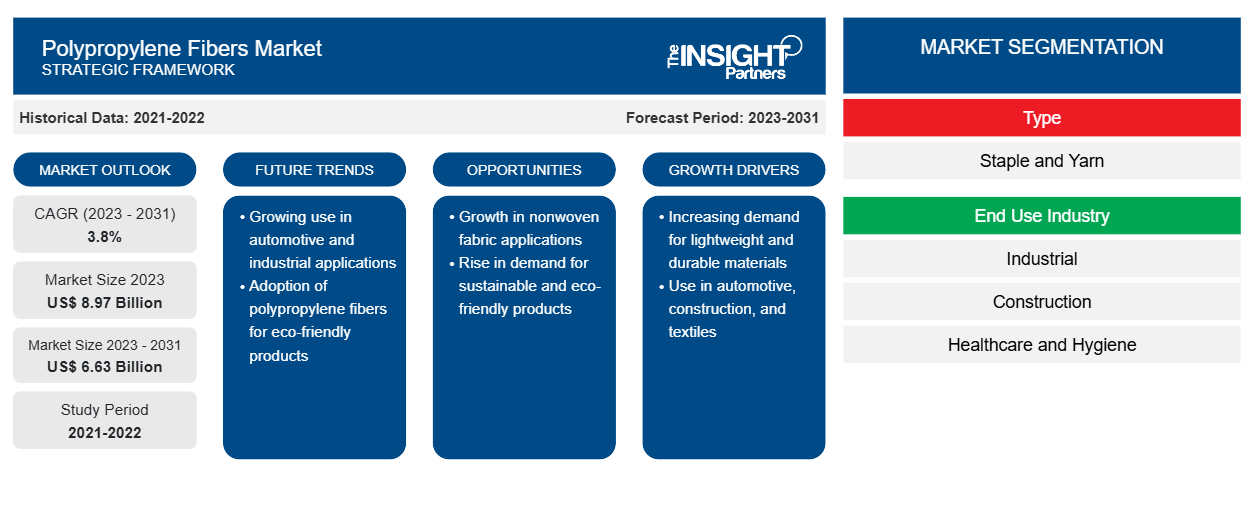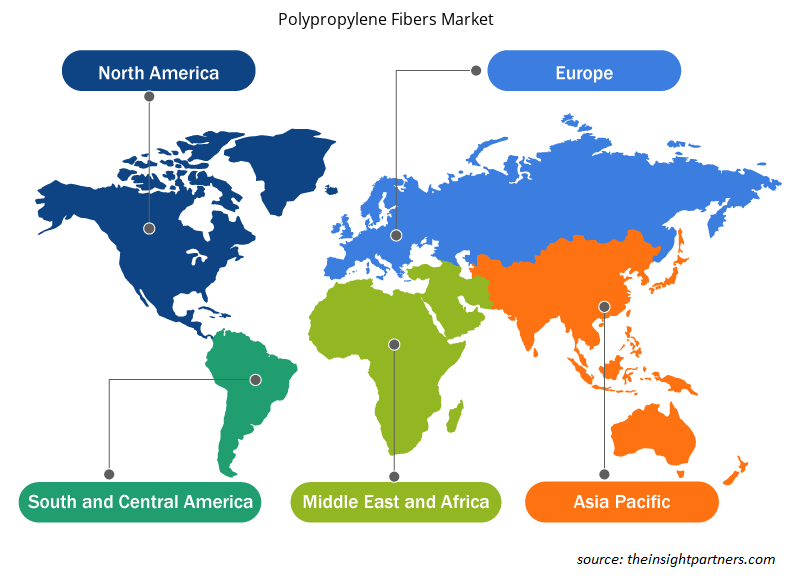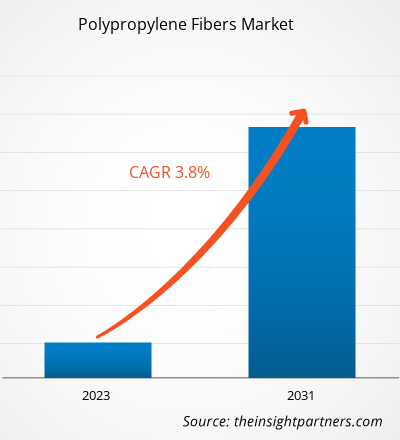The Polypropylene Fibers Market size is projected to reach US$ 6.63 billion by 2031 from US$ 8.97 billion in 2023. The market is expected to register a CAGR of 3.8% in 2023–2031. The demand for healthcare and hygiene products is likely to remain key Polypropylene Fibers Market trends.
Polypropylene Fibers Market Analysis
The growing demand for polypropylene fiber in the construction industry has aided the polypropylene fiber market growth. Concrete is a widely used construction material due to its utilization for sustainable buildings. Polypropylene is often added to the cement matrix to improve the resistance of concrete. Fiber reinforced concrete is much more durable due to an enhanced tensile strength and less likely to crack when compared to plain concrete. The construction industry across the globe is growing rapidly. Further, European countries are creating and strengthening their infrastructure by enacting reforms and legislation, thus driving the real estate and infrastructure industries. According to the European Construction Industry Federation, the volume of permits for new buildings (excluding civil engineering) in Germany was US$ 130 billion in 2021, 8% more than in 2020. In North America, the construction industry is one of the important contributors to the region's economy. As per Associated General Contractors of America (AGC), the US construction industry constructs structures worth US$ 1.8 trillion each year. The rise in construction activities due to the increasing population and rapidly growing commercial sector across the region are driving the construction sector in North America. Such initiatives generate demand for construction services, equipment, and materials. The governments and regulatory authorities in the Asia Pacific are focusing on infrastructure investment. In India, growing industrialization, increasing population, growing middle-class income, and increasing infrastructure development is responsible for the growth in construction activities. According to the National Investment Promotion & Facilitation Agency (India), the Indian construction industry is projected to reach US$ 1.4 trillion by 2025. Moreover, the Government of India initiatives such as Housing for All, Smart Cities Mission, and Swachh Bharat Abhiyan is projected to boost the demand for building materials in India. Thus, the growing construction activities especially in developing economies create an enormous demand for polypropylene fiber. Further, polypropylene fiber is an essential fiber in nonwoven processing and dominates in many nonwoven markets.
Polypropylene Fibers Market Overview
Polypropylene fiber is a kind of linear polymer synthetic fiber obtained from propylene polymerization. It has few advantages such as light weight, high strength, high toughness, and corrosion resistance. The polypropylene fiber is widely used in the chemical industry, energy, clothing, environmental protection, and construction. Polypropylene fiber is a set of synthetic fiber consisting of certain features which make them highly preferable to construction materials, especially when concrete is required. Polypropylene fibers are usually made up of either continuous or discontinuous fiber arranged on a plastic matrix and used as a reinforcement material.
Customize This Report To Suit Your Requirement
You will get customization on any report - free of charge - including parts of this report, or country-level analysis, Excel Data pack, as well as avail great offers and discounts for start-ups & universities
Polypropylene Fibers Market: Strategic Insights

- Get Top Key Market Trends of this report.This FREE sample will include data analysis, ranging from market trends to estimates and forecasts.
You will get customization on any report - free of charge - including parts of this report, or country-level analysis, Excel Data pack, as well as avail great offers and discounts for start-ups & universities
Polypropylene Fibers Market: Strategic Insights

- Get Top Key Market Trends of this report.This FREE sample will include data analysis, ranging from market trends to estimates and forecasts.
Polypropylene Fibers Market Drivers and Opportunities
Growing Demand from Textile Industry
The main application areas of polypropylene fiber in textile includes nonwoven fabrics. According to the report published by the National Investment Promotion & Facilitation Agency in 2020, 13% of India’s total textile market consisted of technical textiles. The report revealed that technical textiles has been a fast-growing segment in India due to increased utilization in defense, sports, healthcare, construction, and automotive applications. Moreover, initiative called “National Technical Textiles Mission” which is set up by the Cabinet Committee on Economic Affairs (CCEA) is to increase the market size of technical textiles with an average growth rate of 15% to 20% by 2024. According to the report released by the United States of America Department of Commerce in 2020, stringent regulations imposed by European governments on personal safety and protective apparel have driven the technical textile and smart fabrics market in Europe. The Chinese Ministry of Industry and Information Technology evaluated the demand for multiaxial fabrics in China to be 400,000 tons per year in 2019. Therefore, developments in the textile industry is driving the polypropylene fiber market.
Rise in Usage of Hygiene Products
Polypropylene fibers are used in the production of disposable hygiene products such as diapers and sanitary napkins due to their high strength, lightweight, softness, and low water return rate. The softness and hydrophobic properties make polypropylene fibers suitable for hygiene products and adult incontinence products. The growing utilization of hygiene products due to rising health awareness is anticipated to hold potential opportunities for polypropylene fibers, over the forecast period.
Polypropylene Fibers Market Report Segmentation Analysis
Key segments that contributed to the derivation of the Polypropylene Fibers Market analysis are base oil, product type, and end use industry.
- Based on material, the Polypropylene Fibers Market is bifurcated into staple and yarn. The staple segment held a larger market share in 2023.
- In terms of end use industry, the market is segregated into industrial, construction, healthcare and hygiene, agriculture, furniture, and others. The textile segment leads the market in 2023.
Polypropylene Fibers Market Share Analysis by Geography
The geographic scope of the Polypropylene Fibers Market report is mainly divided into five regions: North America, Asia Pacific, Europe, Middle East & Africa, and South America/South & Central America.
Asia Pacific has dominated the Polypropylene Fibers Market. The strong growth in the region, owing to the construction sector and increased emphasis on sustainable practices. China and India are witnessing growth in urbanization, and an increase in the residential sector, which offer ample opportunities for key market players in the polypropylene fiber market. China is one of the largest markets for polypropylene fiber, driven by the country's large construction set-up. China is one of the fastest-growing economies in the world. Asia Pacific is also anticipated to grow with the highest CAGR in the coming years.
Polypropylene Fibers Market Regional Insights
The regional trends and factors influencing the Polypropylene Fibers Market throughout the forecast period have been thoroughly explained by the analysts at The Insight Partners. This section also discusses Polypropylene Fibers Market segments and geography across North America, Europe, Asia Pacific, Middle East and Africa, and South and Central America.

- Get the Regional Specific Data for Polypropylene Fibers Market
Polypropylene Fibers Market Report Scope
| Report Attribute | Details |
|---|---|
| Market size in 2023 | US$ 8.97 Billion |
| Market Size by 2031 | US$ 6.63 Billion |
| Global CAGR (2023 - 2031) | 3.8% |
| Historical Data | 2021-2022 |
| Forecast period | 2023-2031 |
| Segments Covered |
By Type
|
| Regions and Countries Covered | North America
|
| Market leaders and key company profiles |
Polypropylene Fibers Market Players Density: Understanding Its Impact on Business Dynamics
The Polypropylene Fibers Market is growing rapidly, driven by increasing end-user demand due to factors such as evolving consumer preferences, technological advancements, and greater awareness of the product's benefits. As demand rises, businesses are expanding their offerings, innovating to meet consumer needs, and capitalizing on emerging trends, which further fuels market growth.
Market players density refers to the distribution of firms or companies operating within a particular market or industry. It indicates how many competitors (market players) are present in a given market space relative to its size or total market value.
Major Companies operating in the Polypropylene Fibers Market are:
- Beaulieu Fibres International
- Chemosvit Fibrochem, s.r.o.
- Indorama Ventures Public Company Limited
- Mitsubishi Chemical Group Corporation
- Radici Partecipazioni SpA
- Fiberpartner Aps
Disclaimer: The companies listed above are not ranked in any particular order.

- Get the Polypropylene Fibers Market top key players overview
Polypropylene Fibers Market News and Recent Developments
The Polypropylene Fibers Market is evaluated by gathering qualitative and quantitative data post primary and secondary research, which includes important corporate publications, association data, and databases. The following is a list of developments in the market:
- Beaulieu Fibres International, the largest and most differentiated European staple fibre producer, turns the spotlight on future-focused solutions for nonwovens & engineered fabrics at IDEA®22, this 28-31 March (Booth 4314). (Source: Beaulieu Fibres International, Press Release, 2022)
Polypropylene Fibers Market Report Coverage and Deliverables
The “Polypropylene Fibers Market Size and Forecast (2021–2031)” report provides a detailed analysis of the market covering below areas:
- Market size and forecast at global, regional, and country levels for all the key market segments covered under the scope
- Market dynamics such as drivers, restraints, and key opportunities
- Key future trends
- Detailed Porter’s Five Forces and SWOT analysis
- Global and regional market analysis covering key market trends, major players, regulations, and recent market developments
- Industry landscape and competition analysis covering market concentration, heat map analysis, prominent players, and recent developments
- Detailed company profiles
- Historical Analysis (2 Years), Base Year, Forecast (7 Years) with CAGR
- PEST and SWOT Analysis
- Market Size Value / Volume - Global, Regional, Country
- Industry and Competitive Landscape
- Excel Dataset
Testimonials
Reason to Buy
- Informed Decision-Making
- Understanding Market Dynamics
- Competitive Analysis
- Identifying Emerging Markets
- Customer Insights
- Market Forecasts
- Risk Mitigation
- Boosting Operational Efficiency
- Strategic Planning
- Investment Justification
- Tracking Industry Innovations
- Aligning with Regulatory Trends
Yes! We provide a free sample of the report, which includes Report Scope (Table of Contents), report structure, and selected insights to help you assess the value of the full report. Please click on the "Download Sample" button or contact us to receive your copy.
Absolutely — analyst assistance is part of the package. You can connect with our analyst post-purchase to clarify report insights, methodology or discuss how the findings apply to your business needs.
Once your order is successfully placed, you will receive a confirmation email along with your invoice.
• For published reports: You’ll receive access to the report within 4–6 working hours via a secured email sent to your email.
• For upcoming reports: Your order will be recorded as a pre-booking. Our team will share the estimated release date and keep you informed of any updates. As soon as the report is published, it will be delivered to your registered email.
We offer customization options to align the report with your specific objectives. Whether you need deeper insights into a particular region, industry segment, competitor analysis, or data cut, our research team can tailor the report accordingly. Please share your requirements with us, and we’ll be happy to provide a customized proposal or scope.
The report is available in either PDF format or as an Excel dataset, depending on the license you choose.
The PDF version provides the full analysis and visuals in a ready-to-read format. The Excel dataset includes all underlying data tables for easy manipulation and further analysis.
Please review the license options at checkout or contact us to confirm which formats are included with your purchase.
Our payment process is fully secure and PCI-DSS compliant.
We use trusted and encrypted payment gateways to ensure that all transactions are protected with industry-standard SSL encryption. Your payment details are never stored on our servers and are handled securely by certified third-party processors.
You can make your purchase with confidence, knowing your personal and financial information is safe with us.
Yes, we do offer special pricing for bulk purchases.
If you're interested in purchasing multiple reports, we’re happy to provide a customized bundle offer or volume-based discount tailored to your needs. Please contact our sales team with the list of reports you’re considering, and we’ll share a personalized quote.
Yes, absolutely.
Our team is available to help you make an informed decision. Whether you have questions about the report’s scope, methodology, customization options, or which license suits you best, we’re here to assist. Please reach out to us at sales@theinsightpartners.com, and one of our representatives will get in touch promptly.
Yes, a billing invoice will be automatically generated and sent to your registered email upon successful completion of your purchase.
If you need the invoice in a specific format or require additional details (such as company name, GST, or VAT information), feel free to contact us, and we’ll be happy to assist.
Yes, certainly.
If you encounter any difficulties accessing or receiving your report, our support team is ready to assist you. Simply reach out to us via email or live chat with your order information, and we’ll ensure the issue is resolved quickly so you can access your report without interruption.















The List of Companies
1. ABC Polymer Industries
2. Avgol Nonwovens
3. Belgian Fibers
4. Chemosvit
5. Fiberpartner
6. Fiberweb PLC
7. Fibre Innovation Technology Sdn. Bhd.
8. International Fibres Group
9. LCY Group
10. W. Barnet GmbH and Co






 Get Free Sample For
Get Free Sample For